The human race has worshipped, basked and over indulged in the sun’s powerful rays since the dawn of time. To lose oneself lying on silver sands beside the magnetic spell of the endless ocean is and always has been a fascinating and distracting pastime.
The ancient Greeks wore special veils, large brimmed hats and rubbed olive oil on their skin, which very effectively generated a uniform and long-lasting film of protection. While this didn’t help much, other civilizations including the ancient Egyptians, developed their very own sun screen, which was a combination of aloe vera, calcite, clay and herbs.
They may have worked somewhat, but aromas were unimpressive and far less pleasant than the modern concoctions furnished by today’s perfume masters, particularly those that work within the halls of our Pittsburgh perfume manufacturing facility.
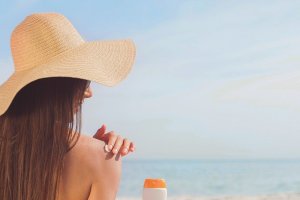
A Brief History Of The Sunscreen Marketplace
The sun screen we all know today dates back to the 1930s and the 1940s. In 1936, a South Australian chemist named Hamilton Blake created a sun burn cream that was fried from impurities by another chemist named Eugene Schueller, who was to become the future founder of cosmetic giant, L’Oreal.
At the same time, Franz Greiter, a chemistry student and avid hiker suffered a bad sunburn while climbing Mount Piz Buin (the range of the Alps on the border between Austria and Switzerland). This inspired him to create the first generation of the Piz Buin sunscreen that is still in use today.
The unmistakable scent of cocoa butter, coconut oil and a hint of jasmine that is most associated with sun screen today was actually created by Benjamin Green, an American airman and pharmacist who developed a petroleum based jelly to protect himself and his comrades from the unforgiving rays of the South Pacific sun during World War II.

According to The New York Times, Green used red veterinary petrolatum, or “red vet pet,” to block the sun’s ultraviolet rays from hitting his skin. While it did do the job, this early sun screen had a very unpleasant smell.
After the war, Green improved his formula and added the above mentioned ingredients. The Coppertone company bought it, and in 1956, introduced its famous logo of a dog and a little girl in bathing suit, and Green’s creation became the iconic fragrance preferred by millions of sun worshippers every summer.
Sun Tan Lotion Versus Sun Screen
Our fragrance creators at Alpha Aromatics fully understand that the term, suntan lotion, is not really used much anymore, and when it does appear it usually refers to a sunscreen with a Sun Protection Factor (SPF) of less than 15. These tanning lotions typically have a range of SPF 4 to 8 and do not provide enough sun protection, especially for children.
Some tanning oils have no sunscreen ingredients at all although they usually do have a tanning accelerator. Parents must be vigilant and make sure children only use a sunscreen or a sunblock that provides broad-spectrum UVA and UVB protection.
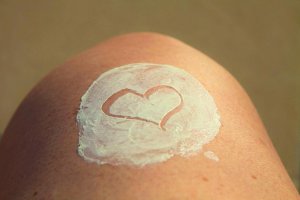
Everyone needs sunscreen and proper use can help prevent skin cancer by offering protection from the sun’s harmful ultraviolet rays that tend to damage the epidermis, where the most common (and least dangerous) forms of skin cancer occur. It is estimated that one in five Americans will develop skin cancer in their lifetime. SPF indicates how long a specific sunscreen can offer this umbrella of protection.
The American Academy of Dermatology recommends that everyone use sunscreen that offers a broad range of protection (SPF 15 to 30 and higher) against ultra violet rays (UVA) and ultraviolet B-rays (UVB ) and water resistance. There is no sunscreen that can block 100 percent of these rays. An SBF of 30 is said to block 97%; 50 blocks 98% and 100 blocks 99%.
Due to the fact that sunscreen and other tanning products are over-the-counter drugs, they fall under the regulation of the United States Food and Drug Administration (USFDA) to determine safety, efficacy, and labeling.
How To Choose An Effective Sun Screen
Just as not all perfume manufacturers possess the expertise and experience offered by Alpha Aromatics, our roots reach as far back as 1940s, not all sun screens are created equal. Consumers must look beyond packaging to make sure ingredients effectively block the sun’s potentially destructive rays. The FDA regulates the safety and effectiveness of sunscreens and their ingredients.
From Oils To Perfume
The only fragrance that truly concerns sun worshippers when the thermometer gets really high is that of sunscreen. For most, a light, barely-there fragrance is very desirable, and for others one that is ever-present is the favored choice.
The all American scent of Coppertone is richly infused with coconut and may not appeal as much to other cultures. Some tanning products have an amber-like sweetness to them, like toasted biscuits, with nuances of warm gingerbread. Whatever the preference, the selected scent should balance with necessary protective chemicals. Options include: sweet, milky and tropical coconut, rich strong bouquets; fresh and clean outdoor scents; floral notes and sweet banana and clean, creamy sophisticated aromas.

The fragrance oils our chemists at Alpha Aromatics select for sunscreen fragrances are developed with better safety and high SBF qualities in mind. Their moisturizing and soothing properties protect the skin against the drying effects of both wind and sun exposure. Vegetable oils are a popular choice as they are easily spread and absorbed.
The most popular vegetable oils are: almond; avocado; coconut; cottonseed; olive; peanut; sesame and soybean oils. All of these are believed to have UV filters, and in general, when applied to skin, these oils are easily absorbed and spread.
The Difference Between Physical and Chemical Sun Screen
According to Dr. David Harvey, M.D, a dermatologist and Mohs surgeon (specialist in skin cancer treatments): “Whether they choose a chemical sunscreen or a physical sunblock, if a patient wears an SPF of 30, I’m happy with it.” That being said, there are some key differences between chemical and physical formulas.”
He goes on to explain that that the mineral ingredients in physical sun screens such as: titanium dioxide or zinc oxide, contain physical blockers that deflect and scatter UV rays away from the skin. He further believe that physical sunblock tends to be less irritating and a better fit for sensitive skin and more moisturizing, which can feel heavy and may not blend fully into the skin. It also offers protection against both UVA and UVB rays as soon as it is applied.
Chemical sunscreens are also known as chemical or organic absorbers. They contain organic compounds, such as oxybenzone, octinoxate, octisalate and avobenzone, which create a chemical reaction that deflects the heat and energy given off by the sun away from the skin. They are a good option for swimmers who need a water-resistant product and they require about 20 minutes to completely absorb into the skin after application.
The Varies Types of Other Tanning Products
There are many tanning products on the market besides regular sunscreen, and making the decision of which one to use can be both confusing and time consuming.
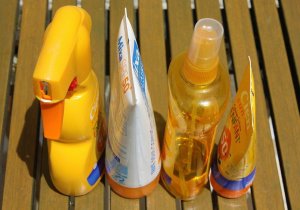
Some tanning products worthy of mention are aerosol-applied sunscreen, suntan lotion and oil and Soothing Aloe Vera after sun gel.
Aeresol Applied Sunscreen
According to a 2018 study published in the Journal of the American Academy of Dermatology, spray sunscreens are becoming more and more popular and their sales are almost equal to top-selling lotions.
Results of this study indicate sunbathers like a quick and easy means of application, and according to Mona Gohara, M.D., an associate clinical professor of dermatology at the Yale School of Medicine: “They tend to be lighter too, so you don’t feel all matted down…Avoid sprays on windy days, as you may be protecting the air more than your skin…Strong gusts can make it more difficult to apply sprays and easier to accidentally inhale them.”
Aerosol sunscreens are known to contain mineral blockers and are a bit more complicated to administer than lotions. They should be applied by first spraying onto hands and then rubbing it in, avoiding contact with eyes and mouth. With sprays there is the possibility that spots will be missed and too little will be applied as needed because it is difficult to actually see how much is being used. Spray enthusiasts claim the best rule of thumb to avoid this is is to spray until skin is glowing.
Sun Tan Lotion And Oil
Choosing between all the available tanning options can be narrowed significantly by the consumer focusing on the purpose of the application. Suntan oils are not known for their SPF protection and function best as vehicles for getting a deep dark tan. Their use should be limited to people with naturally dark skin and be avoided by the fairer and lighter skinned among us unless they already possess a nice tan base. Natural ingredients, such as coconut and sunflower, lend pleasant scents to sun tan oils, which also often linger on the surface of the skin longer than lotions and creams.
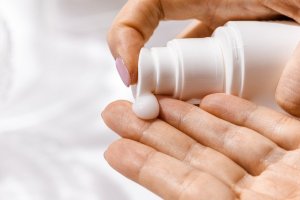
Suntan lotions and creams soak more easily into the skin and leave no greasy residue. They often have acceptable SPF levels and are appropriate for all skin types. The difference between sun tanning oils, lotions and creams lies in the consistency of their texture and how each product feels when applied to the skin. For some sun worshippers, the greasy glow of sun tan oil is very appealing, while others may prefer smoother subtler and less greasy sensations.
Aloe Vera After Sun Gel
This product is very effective for cooling, moisturizing and soothing sunburned skin. The aloe vera restores natural moisture to sun and wind damaged skin and prevents peeling.

Ale Vera, which is also known as the “burn plant” because it forms a protective and soothing layer over burned and peeling skin, is also the American Academy of Dermatology’s first choice recommendation for treating sunburns and the pain associated with them.
Alpha Aromatics and Fragrance Choices For Tanning Products
We have been a leader and pioneer within the perfume industry for decades, and our unified focus, which is to build great scents that build great brands, has remained unchanged since our inception.
Our continued success is the result of a number of factors, the most prominent being our heavy investment in the most innovative scientific tools in the field of industrial science that money can buy, and of course our strict adherence to meeting the guidelines and quality standards set by The Research Institute for Fragrance Materials (RIFM), International Fragrance Association (IFRA), Oregon Tilth, International Sanitary Supply Association (ISSA) and the Natural Products Association (NPA) and the International Organization of Standardization (ISO).

Our laboratories, which are situated in our 85,000-square-foot Pittsburgh Technology Center, are equipped with state-of-the art innovations, such as gas chromatography, mass spectrometry, head-space analysis, distillation, extraction and quality control technology.
5 Trending Fragrance Creations For Sun Tan Products
The following fragrances represent some of our most recent and popular formulations for sun tanning products.
Fire Orchid Pineapple
This inviting scent opens with a top note marked by juicy, woody, crisp and green apple, fresh and dewy melon, tangy black currant and sweet, succulent pineapple. This elements soon fade into a heart note of romantic rose, creamy gardenia, exotic jasmine and powdery, vanilla-like orchid. The fragrance completes with a strong base note of aromatic and very sensual white musk.

Ruby Grapefruit Sage
The top notes of this fragrance contain juicy, honey-like mandarin, sour sweet lemon, and clean, uplifting and tangy grapefruit. They soon give way to a middle note comprised of green, rich and soothing lavender, clean, sharp rosemary, floral, earthy, and nutty sage and sweet, powdery violet. The scent completes with a woody base note nuanced by warm and rich amber.
Coconut Milk & Mango
Conjuring images of basking under the tropical sun besides a glimmering sea shore, this exotic scent opens with a top note hallmarked by gingery, vanilla mango, juicy, luscious orange, sweet tangerine and tart grapefruit. These elements surrender to a heart note of milky coconut, and soft florals. Sweet sugar elegant and creamy vanilla and earthy, sensual musk finish this intoxicating fragrance.
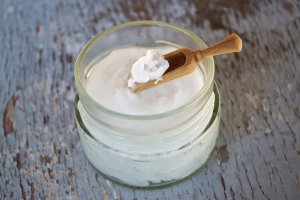
Guava Blossom Kiwi
Vanilla-like, tropical mango, fresh fruity guava, softly sweet kiwi, honey-like, succulent tangerine and fruity, floral passion flower initiate this memorable scent. A middle note soon arises comprised of romantic rose, creamy magnolia, light, bitter neroli, sweet, intoxicating night blooming jasmine and rich, floral, banana-toned yiang yiang. A base note of honeyed amber, powdery vanilla and warn, woody sandalwood completes this delightful fragrance.
Beach Kissed Musk
Its all in the image conjured by its moniker, as far as this sun screen fragrance goes. It opens with a top note of juicy, peppery mandarin, citrusy, fresh and sweet grapefruit peel and fresh marine and ozonic salt sea air. A middle note of intense and exotic beach jasmine, wild, sweet and heady honeysuckle and delicate, warm and floral muquet eventually make way for the base note of earthy amber, dark and warm vanilla musk and sun dried driftwood that finish the scent.
In Conclusion
We are always there to lead the way within the perfume and scent creation industry. Call our team today if your interest lies in developing a new and different scent for a sun tanning product or any other project that involves fragrance creation.
Happy Summer (if possible) to all!
What Gives Sunscreen Its Distinctive Smell?
The unmistakable scent of cocoa butter, coconut oil and a hint of jasmine make up the fragrances of most sun tan products today, but as trends continue to evolve, more and more formulations emphasize other essential oils.
What Are 5 Modern Sun Tan Product Fragrances?
Fire Orchid Pineapple
Ruby Grapefruit Sage
Coconut Milk & Mango
Guava Blossom Kiwi
Beach Kissed Musk
Image credit: Pixabay
 alpha aromatics®
alpha aromatics®